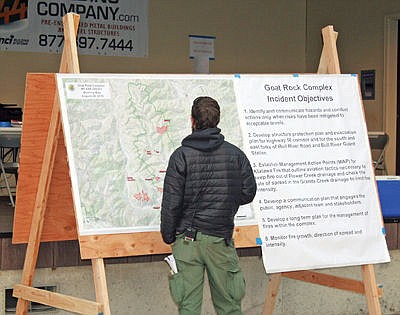Rocky Mountain incident management team takes over Goat Rocks fire complex in Lincoln, Sanders counties
As the sun rises on Libby and most people are just getting out of bed and preparing for their day, members of the Rocky Mountain incident management team are attending their morning briefing.
This team, stationed in Libby’s J. Neils Park and now in command of the Goat Rocks complex of fires, hails primarily from southern Rocky Mountain states of Colorado, Wyoming and South Dakota. They arrived in Libby Saturday for their in-briefing and officially assumed management responsibility for the fires as of Sunday morning. The complex includes eight fires in Lincoln and Sanders counties, including fires at Klatawa Lake, Berray Mountain, Pine Ridge, Vimy, Poplar Point and Chippewa. They will be here for at least 14 days, and although protocol normally limits them to a 21-day deployment, there really is no way of knowing how long they’ll be here.
U.S. Forest Service resource officer for the Kootenai National Forest Quinn Carver was at the team’s Wednesday briefing.
“We know we’re in this for the long haul. We’re glad and thankful that your team is here to help us,” he told the assembled crew.
“We’re at planning level five,” public information officer Carmen Thomason said. “That’s our highest level. Resources are stretched pretty thin and the fire situation and weather situation can get worse. We don’t know how long we’ll actually be here.”
The field at J. Neils Park is full of tents, with trailers parked in various locations around the rodeo grounds and people moving in and out through the various buildings on the grounds.
Thomason said Wednesday there were approximately 60 people on station for the Goat Rocks Complex of fires, but the number fluctuates daily as new resources and personnel arrive and depart.
The team began arriving Saturday and in less than 24 hours the park was like a small city. The team is completely self-contained, bringing their own finance people, GIS, technology and supplies. Supplies are purchased locally as much as possible, Thomason said.
The incident management team and the crews make tremendous personal sacrifices when they’re deployed to fires away from their homes. One member of the team was sent to Libby just one day before his wife’s birthday. Another’s family was evacuated from their home near Couer d’Alene, Idaho, due to fire danger while he was stationed on the Marston fire near Eureka less than two weeks ago.
“Everyone here is dedicated to the job,” Thomason said. “We’re here to work for the community and the people.”
The team is comprised of specialists whose normal jobs run the gamut of positions within a number of federal and state agencies. When fire duty calls, however, their regular duties, families and other plans immediately take a back seat and they mobilize to wherever they’re needed. For 14 days, 21 days or even longer, they live in tents in smoke-filled parks and campgrounds near fire-stricken wildlands.
They work in shifts, but fire doesn’t conform to anybody’s schedule. They’re basically on-call 24 hours a day, seven days a week, with their down time at the mercy of conditions and the needs of the communities they’re working to protect.
For the Red team, stationed at J. Neils Park, the day begins with a 7 a.m. briefing. The division heads report about the previous day’s activities and the expectations and plans for the coming day. After the general briefing, the various divisions break out and hold their own planning sessions.
The buzz-words Thomason used to describe the situation are “fluid” and “dynamic.” The situation can change on a moment’s notice, or with no notice at all. Changes in weather and wind impact the behavior of the fire and those changes can have significant consequences to the teams fighting the fire and the properties they’re working to protect. The team needs to be able to move quickly and respond to those changing circumstances in order to not only protect the community and property, but also to maintain their own safety.
Even though the team members come from different locations and different agencies, when they’re on the fire they work as part of a tight-knit unit.
“We all really depend on each other,” Thomason said. “We work together and rely on each other for our success and safety.”
Thomason ended the tour of the fire camp with an expression of gratitude to the Libby community for their courtesy and support of the visiting team.
“We’re really grateful for this facility,” she said. “And for this community. Everyone has been very welcoming and supportive and the team appreciates that support.”



